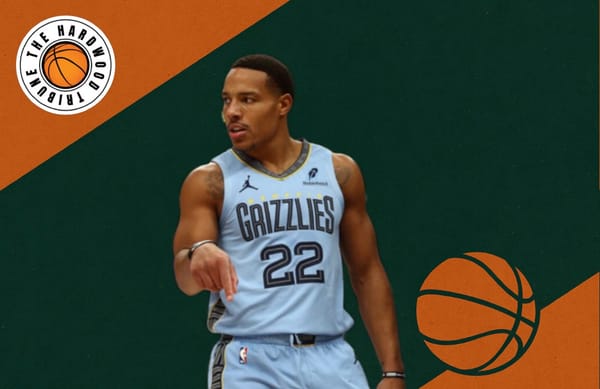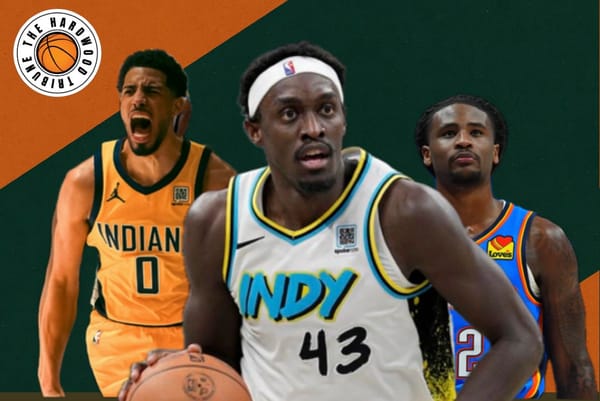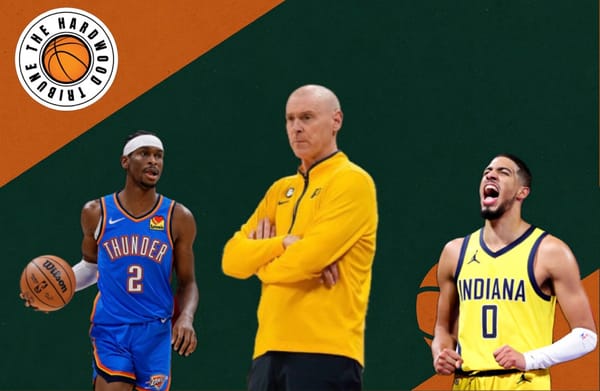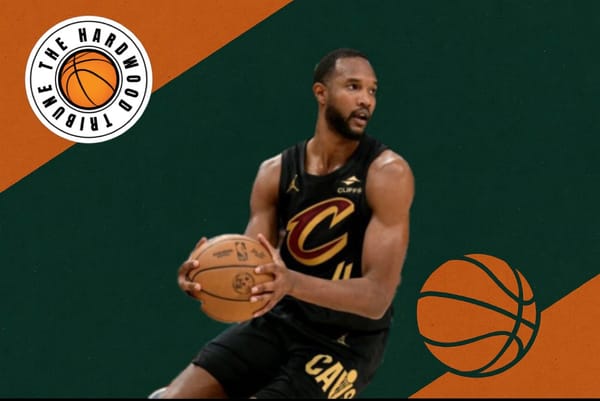(Not-So) Instant Reactions: 2025 NBA Finals Game Two
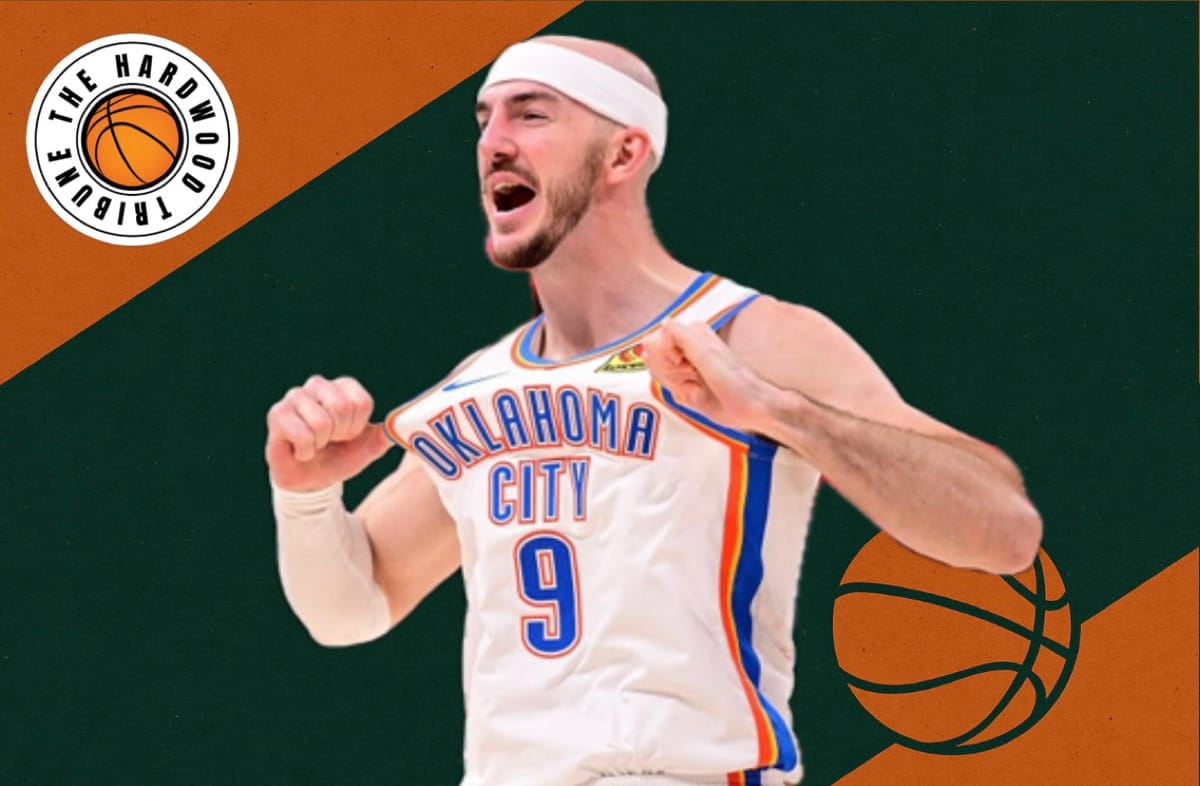
Last night, the Thunder and Pacers each went on a clinic on what to do and what not to do after a loss vs a win in the NBA Finals. The Thunder handled the Pacers 123-107 (which looks closer than it actually was) by reupping on strengths, attacking weaknesses, and feeling the disparity of the situation on the side of the Thunder. The series is all tied up now at 1-1 heading back to Indiana, where both sides will be full of regrets and optimism as the data grows ever so much between both teams on what each needs to do if they want to claim the franchise's first NBA championship.
The Thunder have only fallen on back-to-back games five times this season and have yet to fall this way twice in the Paycom Center. The entire team looked far more energized, focused, and on-point with their shot selections and pure shot-making. The Thunder became the first Finals team to have 5+ 10-point or more scorers in a game since the 2019 Raptors and completely diversified their scoring with big games from quiet players in the previous matchup last week. They decided to double-down on Cason Wallace in the starting lineup and it proved dividends, as bench marks Alex Caruso and Aaron Wiggins each poured in 20 and 18 points, respectively. The shooting splits were close to average, but what made the difference was the sheer volume of shots the Thunder were able to attempt. 40% from three on 36 of them is a more than respectable percentage and is what made the difference against an Indiana team that simply didn't seem ready to encounter such a barrage.
The beginning of the game started slow on both sides, and was reflective of game one, especially for the Pacers. The Pacers shot a miserable 33.3% overall from the field and just above 35% from deep, as the one added three compared to the Thunder is what kept this game as close as it was. This isn't unconventional for Indiana. The team seems to be quite slow-starting when they encounter an opponent like Oklahoma City as shown in quite a jarring way last night. Unfortunately, the sluggish beginning only seemed to get worse, as not-as-bad but still alarming turnover numbers skyrocketed to the top of the box score, and this simply wasn't a day shots were looking to fall for Indiana. The Pacers need to truly look themselves in the mirror and recognize what game they're trying to play heading back to Gainbridge Fieldhouse, as even one loss back in Indiana seems detrimental to the whole series.
The Play is There, the Shooting is Not
While concern should be at the front and center of the Pacers' minds after last night, it's not quite at the level to signal any alarms. To have any shot in this series, the Pacers' number one objective was to put all their chips in to claim at least one game in Oklahoma City, something they did in game one. It's hard to defeat the same team back-to-back; it's even harder against a historically good team like Oklahoma City. The Thunder were still a -10.5 favorite coming into last night's game despite falling in the first game of the series, which just goes to show the incredible reputation this team has built for itself. The Pacers were not expected to win one game on the road this series, let alone two of them back-to-back. The Pacers seemed to be taking better care of the ball last night, and getting to their spots didn't necessarily seem to be the problem like it was in the first half of game one. There were some boxed-out and closed corners here and there, but it was not a grave matter of concern. The problem is not being able to complete those attempts when the look and design are there. 50% on four shots was the highest shooting percentage of any Pacer throughout the first half of this game, with the other four shooting 42.9%, 37.5%, 28.6%, and 20%, all on a minimum of five shots from Tyrese Haliburton. I excluded the second half for this practice as garbage time minutes from the five increased the percentages with no real calories to the shots. Shots that were falling at the end of game one never got rolling for the Pacers throughout the entirety of last night's matchup, and even though the law of averages says not to worry, it should be number one on the whiteboard before game three.
Chet Holmgren is the Mismatch
After a brutal game one where Thunder big man Chet Holmgren only saw the floor for 23 minutes with just six points on 2-9 shooting, the center seemed like the go-to guy when a bucket was surely needed for Oklahoma City, finishing with 15 points on 54.5% shooting last night. In game one, Holmgren seemed lost and didn't quite know his way around the court. On offense, he was being challenged and physically challenged by the more solidly built Myles Turner and was getting lost in the jumbled mess that seems to be the Pacers' offense for 75% of a game. He was losing his confidence quickly, which was imminently proven when Thunder coach Mark Deignault benched him early in the first half and kept him off the court for a good chunk of the crunchtime minutes. Chet seemed to have shown his prowess the Thunder were expecting of him as they chose him second overall in the 2022 NBA Draft; however, as in game two, he seemed much more wary of his surroundings on the court. All it took were those initial four quarters for him to recognize the physicality of this series. Recognizing he simply wasn't going to compete with a big like Myles Turner when it came to bodying down low, he relied on his excellent perimeter game and brought Turner out to the land he likes to roam. Chet had 9 early points in the matchup, most of which were jumpers that splashed in from the same spot just inside the line on the left wing. The Pacers have a clear objective in collapsing the defense to prevent any easy buckets from any potential ball-handler the Thunder throw their way, and so Holmgren studied his spot and would await an inevitable find that he managed to convert throughout the game. Once he proved he was willing to shoot and make these jumpers, he would make any same-sized defender pay by simply beating them off the dribble and forcing either an easy bucket or foul at the rim. This is showing off all without mentioning his ever-present defensive presence around the rim. He finished game two with only a single block on the night, but his length and defensive awareness are enough to keep all Pacer handlers wary of attacking the basket.
No Haliburton, No Offense
This should go without saying as Haliburton is one of the premier offensive engines in the league, but that doesn't seem to always resonate with one of the league's not guards. While Tyrese finished with 17 points and 6 assists, on better than average shooting percentages, this is only the case if you include that he turned over the ball five different times, and the shooting percentages were greatly improved in garbage time during the second half of play. The Thunder played the same trap defense they did in game one, and it once again shook Haliburton to the point of passivity. You saw Andrew Nembhard and TJ McConnell off the bench become the ones to take the ball up the floor while Haliburton revolved around them. This is fine to an extent, Tyrese is an excellent off-the-ball mover and has incredible catch-and-shooting touch- that is, when the ball can get to him. He seems to be suffering from bizarro Chris Webber syndrome at times. Instead of not wanting the ball in the clutch, it seems he only wants to make the play in the clutch. This isn't always the case, of course. This has been the best player on a Finals team putting up some of the best performances seen by any guard in a magical playoff run. It is very clear to all parties that he is a certified shot maker and certainly a certified shot-creator, perhaps the best in the league. But Haliburton goes ghost, and when that happens, the Pacers suffer because of it. This isn't entirely mental or on his shoulders; this is an incredibly well-orchestrated Thunder defense that plays to recognize what they need to do to stop a star like Haliburton from getting going. Haliburton will take the ball and he will drive to collapse, but when you have four different players reaching in to try to strip that ball, it's inevitably gonna go that way more times than not. Adaptability is one of Haliburton's best strengths and, at times, also seems to be one of his worst weaknesses. When you're playing the Thunder, you can't afford one possession of the latter. This Pacers' offensive unit has been an engine that seems unstoppable since the turn of the calendar year, and when (not if, when) Haliburton gets it going, this Pacers team will be very difficult to contain.
The Genius of the Thunder "Defense"
In case it wasn't obvious from my previous Finals-related blogs, I'll put it bluntly: the Thunder rarely play defense. What do I mean? Well, it's quite simple really, the Thunder foul on nearly every, single, possession. This will and rightfully sound like half-hearted complaining from a homer fan, and I'll take that in all its might as it is surely true to some extent, but this is something I've been preaching all year, and none worse than in the Nuggets series a few weeks back. Yes, the Finals are more physical. No, the officiating has not been objectively worse against the Pacers than it has against the Thunder, and it certainly isn't the reason the Pacers lost game two. But what is true is that the Thunder get away with so much more than any other team because they do it every single time on the defensive side of the floor. You can play it in your head down to a tee. Any player taller than 6'10 receives the ball, a stocky forward such as Caruso or Dort switches onto them, the ball-handler turns their back to continue the offense, Caruso or Dort proceed to manhandle the ball-handler until they force them off-balance or into a stupid pass into a turnover because they want to get rid of the ball before they fall to the ground and have a pack of rabid dogs dive at them trying to force a turnover or jump ball. Again, and I cannot reiterate this enough, the Thunder defense is incredible with or without this method, but it doesn't take great eyesight to recognize they're hacking at any chance they get. It takes a special amount of physicality (or possibly homerism from a writer) to feel like a team is getting away with something when they're the team with a lesser amount of free throws, but the Thunder embody that to their very core. I'm also not trying to say these never get called either. I can envision multiple times (especially on loose balls) where the Thunder get called for a foul that seemingly hasn't even really developed yet because of the anticipation, but that shouldn't be a problem in the first place. It is ridiculous to try and ignore how physical this team plays in a negative way. It is just as ridiculous to act like the Thunder don't get away with things because the simple fact of the matter is the refs cannot call it every single time. If they did, there would be multiple player ejections in the first half. But at the end of the day, this is a backhanded kudos to Deignault and this Thunder team, who broke the system like James Harden in the late 2010s. In the case of Harden, it was, "why wouldn't I collapse after this three if they're gonna call a foul?", and for the Thunder, it is, "why wouldn't I try to leave a claw mark on my opponent if they're not gonna call it?". You can call it dirty or you can call it physical, as long as you recognize that it's also smart.
Follow/contact the Hardwood Tribune:
Website: www.thehardwoodtribune.com
Instagram: @hardwoodtribune


